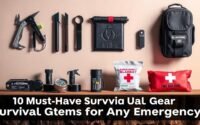Decision Criteria: When to Stay, When to Go
Nearly 40% of people say they regret major relationship splits later in life. That surprising figure shows how vital a clear plan can be before you act.
You face a tough situation now. Experts note people who move toward a goal—like building a stable home or improving behavior—get better outcomes than those who flee pain. That makes sense if you want a durable result.
In this short guide you will learn a repeatable process. It separates soft reasons, such as poor communication, from hard reasons, like abuse or addiction. You will see how weighted scores and uncertainty discounts cut regret.
Proper planning and careful thought are your first line of survival. Bookmark this page and return often for updated survival prep and practical steps that protect your life, relationships, and kids today.
Key Takeaways
- Use a clear process so your choice makes sense now and later.
- Separate temporary discomfort from true dealbreakers.
- Weigh safety, communication, resources, and children fairly.
- Apply a simple weighted matrix to reduce second-guessing.
- Test reversible options first when possible.
- Plan carefully; good prep reduces long-term regret.
Why this decision matters today: clarity under pressure in survival situations
Pressure narrows your options unless you set a simple process fast. In urgent contexts, a short plan brings clarity and keeps you from reacting to the loudest fear in the room. Proper planning and careful consideration act as your first line of survival.
A structured approach helps when facts are missing. It shows which problems can improve with communication and which demand immediate protection for health and family. Use time-boxed steps so you act when it matters without skipping essential checks.
“A repeatable method blends quick gut checks with rational scoring and reduces long-term regret.”
- Create clarity fast so you protect health and meet urgent needs.
- Use brief stabilization steps: breathing, a list, a trusted call.
- Follow a simple course: define the problem, gather facts, weigh options, pick next steps, review.
| Type | Example | Action |
|---|---|---|
| Solvable | Poor communication, stress | Support, counseling, time-boxed trials |
| Urgent | Abuse, severe addiction | Immediate safety planning, exit, health care |
| Stabilizers | Breathing, list, trusted contact | Short-term clarity tools |
For evidence on structured approaches and relationship outcomes, see this summary of research: relationship research review.
Decision Criteria: When to Stay, When to Go
Begin with a simple label: is this immediate harm, rising risk, or long-term strain? Naming the situation gives quick direction and reduces anxiety.
Define the situation
Labeling matters. Immediate danger (abuse) needs urgent exit and protection. An unfolding risk calls for facts and short-term safety plans. Chronic strain may respond to focused repair.
Set your goal
Frame your choice as moving toward safety, health, and stability rather than only away from pain. Counselors note this makes plans more sustainable and clearer over time.
Balance needs with impact on others
Write down your needs—physical safety, mental health, finances, housing—and note what each choice means for partner, spouse, and children.
- Use a “today vs. five years” view for clarity.
- Turn vague things into specifics: frequency, triggers, effects.
- Decide one next safe step—repair plan, trial separation, or exit—and set a reassess date.
Proper planning and consideration are two of the more important keys in survival prep. Take them seriously.
Soft vs. hard reasons: separating discomfort from dealbreakers
Separate softer problems from clear danger so your next steps match the real situation.
Soft reasons are issues that often respond to focused work. Examples include poor communication, frequent arguing, feeling distant, or saying “we grew apart.” These things can improve with targeted support, counseling, or time-bound experiments.
Hard reasons cross safety lines. Abuse, active addiction, and severe betrayal require protective action, documentation, and exit planning. Do not treat these as repair projects.
“Use your pain as data: if repair efforts fail and harm grows, reclassify the situation and act.”
- Map feelings: is this pain you can work on, or fear that demands protection?
- If soft reasons dominate, try structured communication work and set clear milestones.
- If hard reasons appear, prioritize safety, trusted help, and a concrete exit plan.
Plan the work, but don’t let work excuse harm. Keep life goals visible so you do not confuse temporary discomfort with a true dealbreaker.
Fear-based vs. action-based choices: how motivation shapes outcomes
Your reasons for moving are as powerful as the move itself. Motivation steers the way you plan and how you recover. People who act from hope and goals tend to make changes that last.
Recognize fear lenses: avoiding pain, loss, or loneliness
Watch for spirals that start with fear. Thoughts like “I’ll never find love again” or “I can’t make it without my partner” narrow options and freeze action.
Aim for goal-directed action: stability, growth, and healthier lives
Reframe your motives to forward-looking goals: building a stable home, choosing health, and modeling resilience for children. Use feelings as data, not the full plan.
Shift modes: training, support, and small wins to move from fear to action
“Motivation is trainable: small, repeated steps build confidence and change outcomes.”
- Spot fear-based narratives and name them aloud.
- Reframe into action goals and list two steps you can take this week as an example.
- Track feelings, but weigh them alongside safety, finances, and support.
- Share a short plan with a trusted person for accountability.
- Celebrate small wins and remove triggers that feed fear.
| Mode | Typical thought | First action |
|---|---|---|
| Fear-based | “I’ll be alone; I’ll lose contact” | Name the fear and call one trusted person |
| Action-based | “I’m building stability and growth” | Schedule one concrete step toward housing or therapy |
| Training/support | “I can learn habits that help” | Book a coaching or peer-support session |
Proper planning and consideration are two of the more important keys in survival prep. Define one small action you can take in the next 24 hours that proves movement is possible. Over time, those steps change how you feel and what you can achieve.
A practical how-to: build a stay-or-go decision matrix
Use a compact matrix to turn feelings into measurable steps and clearer plans.
Start by listing your options: stay and repair, trial separation, temporary relocation, or leave with a full exit plan.
List your drivers
Take account of safety, health, children, communication, finances/resources, housing, and available time.
Proper planning and consideration are two of the more important keys in survival prep.
- Assign weights to drivers (example: safety 40%, kids 25%, health 15%, communication 10%, resources 10%).
- Score each option per driver (1–10) and apply an uncertainty discount for unverified assumptions.
- Add an urgent-constraints column for court orders or medical needs so non-negotiables stay visible.
- Ask one clarifying question per driver: “What proof do I have of improvement?”
- Time-box your work (72 hours gather facts, 24 hours score) and save the matrix to review later.
| Option | Sample score (safety/kids/comm) | Notes / urgent constraints |
|---|---|---|
| Stay & repair | 6 / 5 / 7 | Requires verified therapy progress; no urgent legal needs |
| Trial separation | 8 / 8 / 4 | Preserves routines; monitor communication plans |
| Leave with exit plan | 9 / 6 / 3 | Best for active harm; check housing and finances first |
Combine gut feel with the matrix result. If they disagree, note why, adjust weights if needed, then make your decisions with more clarity. This way you treat the problem fairly and protect relationships while you act.
When others’ decisions affect yours: reciprocal dynamics and fairness
Your plan rarely unfolds in isolation; others will react and reshape the path.
Map likely responses from your partner or spouse for each option: supportive, neutral, or obstructive. This helps you pick actions that keep safety and basic needs intact.

Balance fairness with self-protection. Clarify what is equitable for family logistics, finances, and parenting time without sacrificing your safety or core needs.
Separate one-time negotiations, such as immediate safety moves, from ongoing dynamics like co-parenting. That sets clearer expectations for everyone involved.
“In intertwined relationships, your plan often triggers responses that change the landscape.”
- Decide which cooperation you require and what you can do independently if cooperation fails.
- Use brief, factual written messages to reduce conflict and document agreements.
- Check whether identification with family makes you over-give; protect your health and stability first.
Build a backup plan for the people implicitly in your circle—children and extended family—and reassess often as reciprocal dynamics evolve.
Reversible vs. non-reversible paths: test, iterate, or commit
Small, reversible moves let you learn what really helps your family. Use testing steps when safety is not at risk. This gives you options and time to gather facts.
Reversible options include trial separations, temporary relocation, and staged plans. Set clear timelines, rules, and routines for children and kids. Define one or two measurable changes you expect during the trial, such as steady respectful communication or completion of treatment.
Non-reversible thresholds
Hard limits—abuse, coercive control, or severe trust betrayal—mandate decisive action. These problems end experiments. Protect your health and safety first and begin exit planning if these signs are present.
“Proper planning and consideration are two of the more important keys in survival prep.”
- Use reversible paths first when safe: trial separation with timelines, temporary relocation, staged exits.
- Document safety steps: emergency contacts, safe lodging, and legal consultation.
- Include children and kids in every plan; preserve stability and routines for them.
- Prepare logistics for both repair success and for a full exit so you are not caught off guard.
- Ask: “If I look back in five years, which path protects health and dignity?” Use that answer as a guide.
| Option | Typical goal | Key checklist |
|---|---|---|
| Trial separation | Test repair progress | Fixed dates, parenting plan, measurable benchmarks |
| Temporary relocation | Lower immediate risk | Safe lodging, finances, child routines, legal consult |
| Staged exit | Gradual independence | Separate rooms, then housing; track stress and safety |
| Immediate exit | Protect life and well-being | Emergency contacts, shelters, legal orders |
Step-by-step process to make the decision with confidence
Pin down the single safety or stability issue that matters most right now. Make that one-sentence anchor so your choices match urgent needs and future goals.
Clarify the problem: today’s risks vs. five-year future
Write one sentence that names the short-term risk and one sentence that shows how each option looks in five years.
Example: “I need a safe, stable plan for me and my children within 60 days.”
Weigh options with uncertainty discounts and communication checkpoints
List options and drivers: safety, health, finances, children, and communication. Assign weights and score each option.
Discount fragile assumptions. Set clear checkpoints—what will be measured, who reports progress, and how often.
Decide, act, and review: minimize regret, maximize learning
- Define a deadline to end analysis and pick one path.
- Take small, sequenced steps: secure documents, consult counsel, book therapy, adjust routines.
- Review after a set time (e.g., 30 days) and compare results to your five-year view.
- Track pain signals and escalate to your safety plan if harm rises.
- Engage legal, financial, or therapeutic work as needed and capture lessons learned.
Proper planning and consideration are two of the more important keys in survival prep.
Conclusion
, Close by naming one next step that protects dignity and moves you forward.
Proper planning and consideration are two of the more important keys in survival prep. Take them seriously as you face this situation and the choices ahead.
Use a simple process that honors safety, family, and time. Soft problems often respond to focused work, while hard thresholds demand decisive action. Test reversible paths when safe; commit to non-reversible steps only for active harm.
Keep your life goals visible and align daily work with the relationships and stability you want. Make one small choice today that proves care for yourself and shows accountability to your plan.
We update this guide regularly. Bookmark it and come back for tools, checklists, and fresh ways to protect your future, your children, and the lives of people you love.
FAQ
How do you define whether the situation is immediate danger, unfolding risk, or chronic strain?
Start by listing facts you can verify right now: threats to physical safety, legal risks, or health issues count as immediate danger. Unfolding risks show escalating signs that could become urgent within weeks or months. Chronic strain is ongoing stress that harms well-being but doesn’t pose immediate physical danger. Use timelines and input from trusted professionals to clarify which category applies.
What should your primary goal be when choosing to stay or leave?
Aim for safety and health first, then long-term stability and growth. That means prioritizing children’s welfare, your mental and physical health, and practical needs like finances and housing. Moving away from fear isn’t enough; choose the path that most reliably supports a healthier life for you and anyone dependent on you.
How do you balance personal needs with the impact on kids, partner, or family?
Map the effects of each option on every person involved. Consider short-term disruption versus long-term benefits. Communicate clearly with family when possible, seek professional guidance for custody or care decisions, and prioritize actions that keep children safe and emotionally supported.
What separates discomfort from a dealbreaker in a relationship or situation?
Discomfort often feels unpleasant but is resolvable through communication, therapy, or practical changes. Dealbreakers include ongoing abuse, repeated boundary violations, or health risks that won’t change despite efforts. If repeated patterns persist after honest attempts to fix them, treat them as non-negotiable.
How can you tell if fear is driving your choice instead of reasoned action?
Check for avoidance patterns: decisions made to escape short-term anxiety rather than improve long-term outcomes often follow fear. If your plan lacks specific, goal-directed steps (safety, finances, support), pause. Seek input from a counselor or trusted friend to test whether fear or strategic goals are guiding you.
What are practical steps to move from fear-based thinking to action-based planning?
Break the problem into small, testable steps: gather facts, set a safety plan, secure resources, and schedule a trial period for any changes. Build supports such as friends, therapists, or legal advice. Celebrate small wins to build momentum toward a stable outcome.
How do you build a stay-or-go matrix that actually helps you decide?
Create columns for options and rows for drivers like safety, health, children, communication, finances, and time. Score each cell by how well the option meets the driver. Add notes on reversibility and timelines. The matrix reveals trade-offs and exposes which option best aligns with your priorities.
What should you do when others’ choices significantly affect your options?
Identify which parts you can control and which you cannot. Negotiate fair reciprocity where possible, and document agreements. If another person’s behavior threatens health or safety, prioritize protective steps for you and your children over fairness or shared plans.
How can you test reversible paths without burning bridges?
Use time-bound trials like temporary separation, short relocations, or phased changes to test whether problems improve. Set clear criteria and checkpoints to evaluate progress. Keep lines of communication open and maintain legal and financial safeguards while testing options.
What situations should be treated as non-reversible thresholds requiring immediate commitment?
Immediate responses are warranted for severe physical or emotional abuse, persistent betrayal that endangers health or financial security, or legal and medical emergencies. In these cases, prioritize safety plans and professional intervention rather than incremental testing.
How do you clarify today’s risk versus a five-year outlook?
Build two scenarios: one focused on immediate threats and one projecting five years based on current trends. Use concrete markers—health outcomes, career prospects, financial stability, and relationships—to compare. This helps you choose options that manage urgent risks while supporting a better future.
What are uncertainty discounts and communication checkpoints, and how do you use them?
An uncertainty discount reduces the weight of overly optimistic predictions; it forces you to plan for setbacks. Communication checkpoints are scheduled conversations to review progress and adjust plans. Together, they keep decisions flexible, realistic, and accountable.
How do you decide, act, and review without getting stuck in regret?
Commit to a plan with clear metrics and a review date. Take decisive action on immediate safety and practical needs. After the review, learn from outcomes and adjust. Treat choices as experiments: you reduce regret by focusing on information gained rather than imagined perfect results.
What role does professional help play in making these choices?
Professionals—therapists, legal advisors, financial planners, and social workers—provide facts, safety planning, and options you might miss. Engage experts early when risks involve safety, custody, or legal complexity. Their perspective helps you make informed, sustainable choices.


